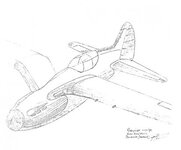The LaGG-3 was not that large of an airframe amd accepted the Su-2's engine/cowling well enough.
It was slightly bigger than the I-185, and Su-2's (Soviets were calling the ASh-82-powered Su-2 as Su-4) engine was both smaller and lighter than the M-71 engine.

